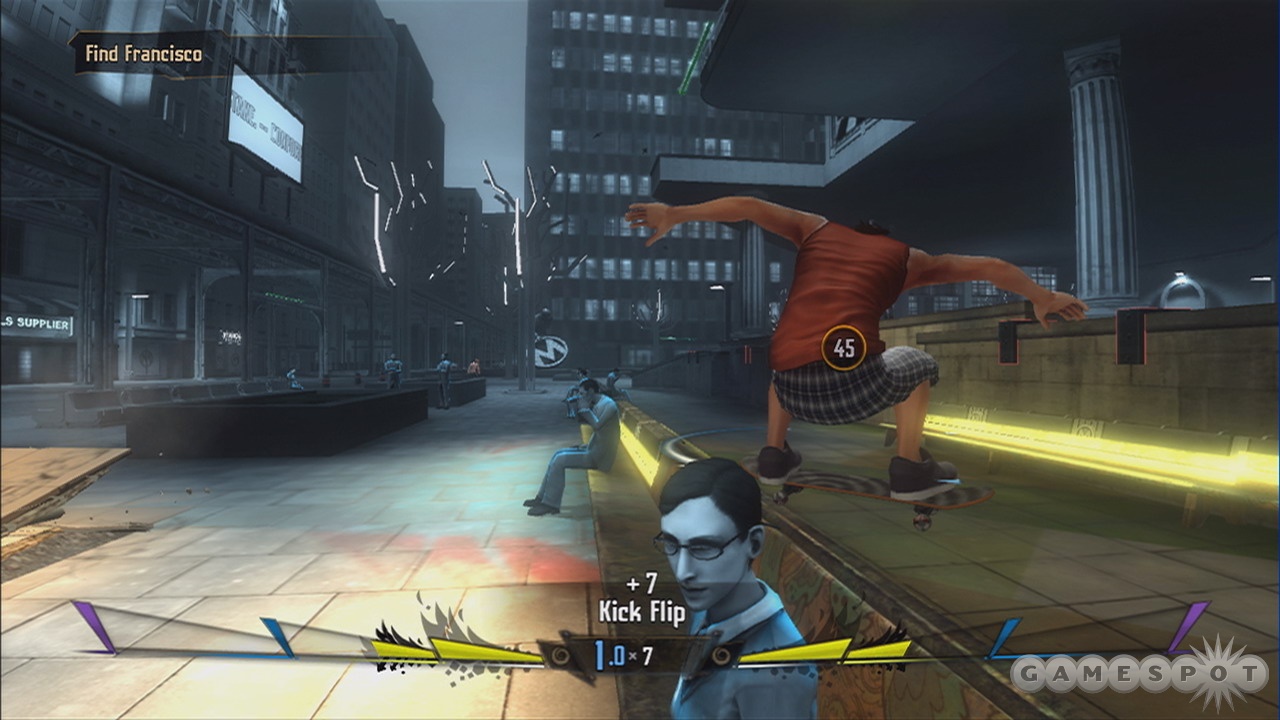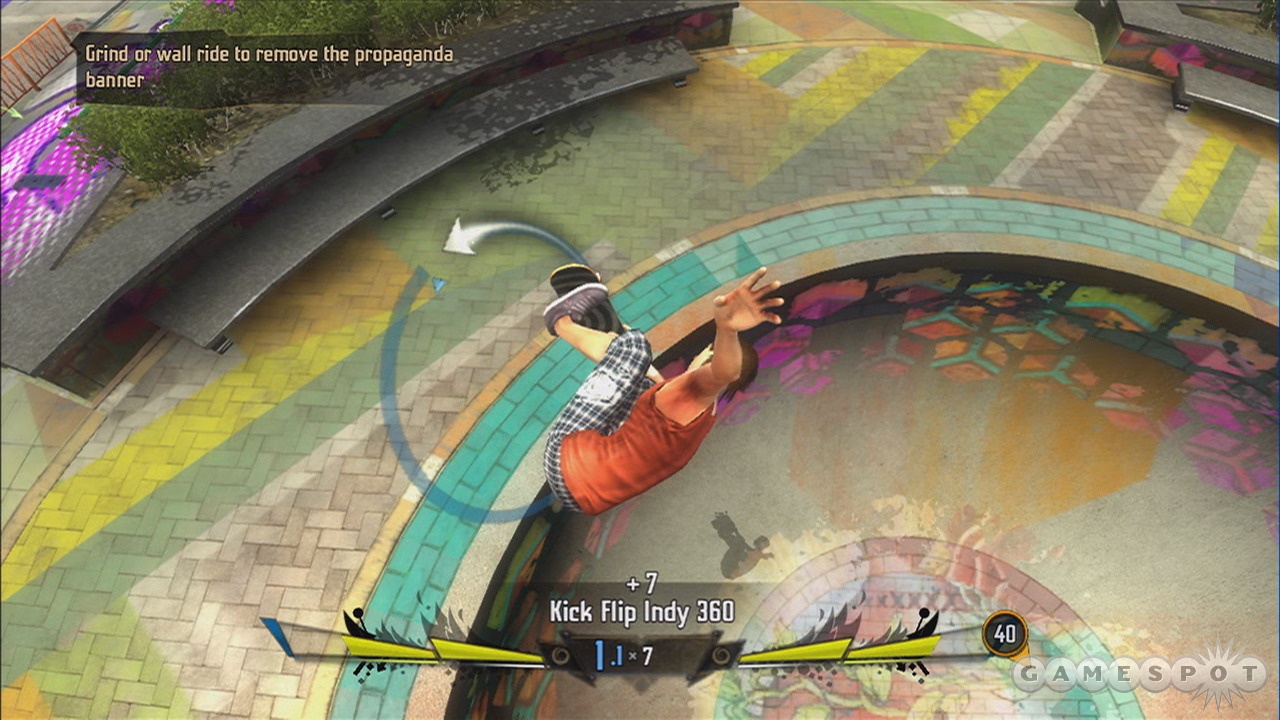In Shaun White Skateboarding, you restore joy and freethinking to an oppressed and conformist world. One of the game's great ironies is that you do so by uncovering Stride Gum billboards in a city abounding with Wendy's fast-food restaurants. Blatant product placement is nothing new in skating games, but it sure sticks out when your entire purpose is to break free from a manufactured society. But the irony doesn't end there, as the game's latter half isn't really a skateboarding game at all, but is rather a puzzle platformer in which you spend large amounts of time figuring out how to get from point A to point B. Unfortunately, this shift in priorities comes at the expense of fun. When it focuses on skateboarding, the game is unspectacular but good fun; when it veers off the rails, it becomes slow and tedious.
The tyrannical organization called The Ministry has removed all the color and soul from your beloved city. Ministry propaganda is everywhere, and the citizens wander about like mindless drones. Even worse? Shaun White is one of the few skilled enough to stand up to this regime, but he's been taken prisoner in one of the most elaborate constructs ever to house a menace to society. It's up to you and your helpers to free the minds of the populace and set Shaun loose. Is the plot kooky? Oh yes. Is it entertaining? Sometimes. There is some charm in the ridiculousness, mostly in the form of characters that guide you through the story mode. A squealing lady's man with long tresses and a gift for melodrama may come across as a caricature, but he's comical at least, as is an excitable skater who drops a few choice bits of profanity. (A few lines of dialogue may have you wondering how this game managed to skate by with a T rating.) The biggest problem with the story is that it doesn't go far enough. Sometimes it comes across as tongue-in-cheek camp; other times, it strikes a serious tone, as if trying to sell you on this ridiculous setup. Thus, it settles on a slightly uncomfortable middle ground that isn't realistic enough to inspire a connection to the world--or to Shaun, who functions only as an abstract plot device--or outrageous enough to wholeheartedly commit to its subject matter or visual style as fully as Jet Grind Radio, a game that did much more with a similar premise.
That middle-ground approach permeates all of Shaun White Skateboarding. To return color to this muted world, you do tricks to earn "flow." If you earn a proper amount of flow, your landings cause a wave of color to erupt from the ground below you. Ramps burst forth where there were none before, and that which was dull and gray takes on color. The brainwashed citizens snap out of their trance, riding skateboards of their own and crying out such inane lines as "You're making a difference!" and "Shake it like a picture!" ("You've got a nice long one!" is a memorable if still not particularly good one of these.") That isn't to say the world becomes vibrant, exactly. The color-restoration effect is neat for a while, and there's joy to be had when you feel like your tricks are having a tangible effect on your surroundings. You might now vert skate where you couldn't before, and cool sculptures may even rise from the ground. But the colors aren't strong and the art isn't exaggerated, so increasing your influence is more like spreading a mild tint than splashing the city with vivid hues. Again, the game doesn't go far enough, failing to fully embrace its style and seeming halfhearted as a result.

The game's other signature facet is shaping. You can extend green-hued rails and shape them as you skate, allowing you to reach higher areas or other points of interest. Skating onto a transparent vert ramp causes it to spring to life, and wide ribbons turn into impromptu streets. As you progress, these features evolve. Eventually, you can raise platforms upward or pull them down to reveal tunnels and even create rails out of thin air. Shaping edges and platforms is pretty neat in the first half of the game. It takes a bit of time to get used to the controls when shaping; the left analog stick, normally used for navigation, controls the direction of the rail once you've begun shaping, so you have to make a mental adjustment, lest you veer off in a direction that you didn't intend. Once you get used to this quirk, shaping is a pleasant addendum to the skating, helping you to reach high areas for completing objectives and finding icons that unlock new clothing choices, as well as other odds and ends.
The skating isn't as freewheeling as that of earlier Tony Hawk games or as focused on authenticity as the Skate series. But it feels fine when it gives you the freedom to make your own fun, having you flick the analog sticks to perform your various skills, more of which can be purchased via the in-game skate shop. Vert skating is particularly enjoyable, and there are multiple deep crevasses that give you ample opportunity to catch air. Some areas are a joy to navigate, such as an amusement park featuring a derelict roller coaster and a downtown area featuring theaters and towering billboards. These regions are packed with benches to grind and ramps to exploit. Later portions send you to less-interesting places with fewer chances to get your groove on, like large control rooms and confining rooftops.
This change in scenery comes with a change in attitude. About halfway through, Shaun White Skateboarding stops being a skating game and becomes a tedious platformer. You must complete objectives (take out these flow-zapping pylons, destroy these cameras) by using shaping rails and platforms in very specific ways. Suddenly, the pace grinds to a halt, and you spend more time figuring out how to get to your destination and manipulating ramps than you do performing tricks or transforming the world. More problematic is that it isn't that fun to figure out which rails need to be shaped in what ways to complete an objective. The more specific an objective is, the less cooperative the controls are; rails pull you on to them even if you don't want to grind them, and long grinds make constantly having to adjust your balance an annoyance. (Falling from on high during a timed mission is one of the game's most frustrating occurrences.) For several hours, you spend precious little time doing the fun stuff (tricking and verting) and far too much time figuring out how to get from point A to point B. You also spend way too much time performing a hacking minigame, which involves moving a marble past various obstacles until you reach the destination, a la Marble Madness. Not only does the hacking feel out of place, but the controls are too slippery for it to be all that agreeable.
You may have had hopes that multiplayer would bail out the disappointing single-player experience, but it doesn't significantly improve Shaun White Skateboarding's value. The modes are solid and lag-free, having players compete for points by accumulating flow and shaping objects, either online or in split-screen. Unfortunately, it's incredibly difficult to find just one other person online, let alone seven others for full team battles. What's left is a mildly enjoyable skateboarding game and a monotonous puzzle platformer, an uncomfortable mixture of game philosophies delivered in a package unwilling to commit to the features that might have helped it excel.
